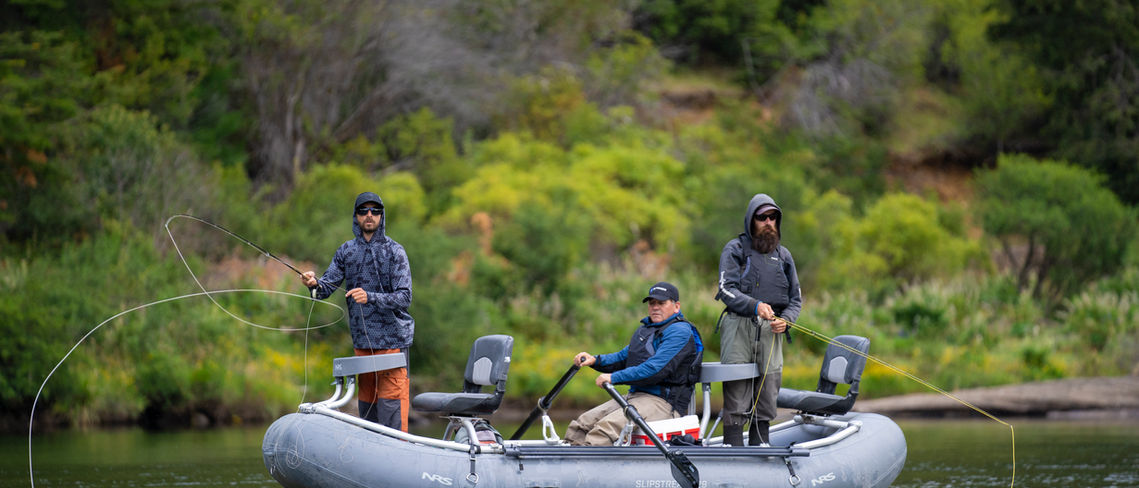

Cisnes River Lodge was born from the meeting of passionate fly fishermen and a magical place at the edge of the world… PATAGONIA.
The lodge was envisioned as a sanctuary for those who live fly fishing as an art form, as an adventure.
More than just a place to stay, Cisnes River Lodge is a place for connection and storytelling—where we can already hear the tales of epic battles with voracious trout that impress even the most experienced anglers.
Surrounded by untouched landscapes and crystal-clear waters teeming with life, each day becomes a chapter in an unforgettable story.
As you drift down the Rio Cisnes, dry flies tempt wild trout in waters nearly untouched by fishing pressure—making every catch a rare and unique moment.
Beyond the river, tributaries and lakes hold unexpected surprises for those willing to explore further.
Why Choose Cisnes River Lodge
.Where it all started
Drift fishing: Enjoy world-class fishing from the comfort of a fully equipped drift boat.
A different fishing experience: Wade through gravel-bottom rivers in search of trophy trout. The clear waters and gentle current make for an enjoyable and immersive experience.
Tailored organization: Only two anglers per guide ensure personalized attention and expert advice.
Professional approach: Fishing zones are selected daily based on environmental conditions and seasonal timing.
Experienced guides: A team of multilingual guides led by an international fly fishing competitor offers diverse perspectives and techniques.
Consistent catches: Impressive trout are caught regularly, creating lasting memories.
High-end comfort: Premium accommodations and gourmet cuisine for an unforgettable stay.
Adventure calls: Add extra magic to your week with overnight bivouacs by remote lakes or river sections that require more than a day’s fishing.
The Fishing
.What to expect on the water
Fishing equipment
Bring the right gear to make the most of your experience at Cisnes River Lodge. Here are some essentials:
Rods & Reels
-
Single-hand rods (5-6 wt): Ideal for dry fly and nymph fishing
-
Single-hand 7 wt: Great for streamer fishing
-
Strong drag reels: Essential for fighting big browns and powerful rainbows
* For the lovers of the light double-hand or switch rods (7–9 wt, 11–13 ft): Perfect for wet flies and streamers
Lines & Leaders
-
Floating lines (5–6 wt): A 6 wt is recommended for windy conditions
-
Sink-tip or full sinking lines: Useful for streamers in deep pools or targeting aggressive King Salmon
-
Tapered leaders (9–12 ft, 2X–4X): Adjust to water clarity and target species
Flies
-
Dry flies: Large attractors, parachute mayflies, stonefly imitations
-
Nymphs: Weighted nymphs, stonefly patterns, classic Pheasant Tails
-
Streamers: Woolly Buggers, Zonkers in black and olive for browns, rainbows, and Kings
Clothing & Accessories
-
Waders: Essential for fishing the river and tributaries. Felt or rubber soles (no metal studs on boats)
-
Layered clothing: Patagonia’s weather is unpredictable—pack thermal layers, waterproof outerwear, and sun protection
-
Polarized sunglasses: Crucial for spotting fish and reducing glare
-
Quality vest or pack: For flies, tippets, and essentials. Don’t worry—your guide will always have what you need
Culinary Experience
A French chef who also offers tastings of Chilean delicacies

Cisnes River Lodge
Season 2026: November 17th, 2025 – March 29th, 2026
Prices are in US$ and per person
Dec 28 - Jan 13
$12,950
Dec 28 - Jan 13
$14,950
Dec 28 - Jan 13
$12,950
Rates are based on 7 nights and 6 days fishing, and include single room (subjected to availability) and shared guide.
Fishing Licenses: $- per person
Non-angler: $- per night per person
* Saturday to Saturday weeks include:
-
-
-
-
Included
-
Transfer from
-
-
-
All meals, wines, beer and local and international spirits
-
-
-
-
Not included
-
-
-
-
-
Laundry service
-
-
-
Gratuities for guides and house staff
Combine Your Trip
Make the most of your time in Patagonia by pairing your stay at Cisnes River Lodge with another premier fishing experience
Whether you want to explore more legendary waters or add a thrilling big-game or wingshooting adventure, we offer seamless extensions to complement your trip.
Untouched rivers teeming with wild trout set in breathtaking landscapes, your journey doesn’t have to end when you leave the Cisnes River—it can continue with another unforgettable sporting experience.




















































